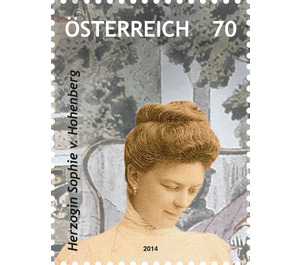100 years - Austria / II. Republic of Austria 2014 - 70 Euro Cent
Theme: History & Politics
| Country | Austria / II. Republic of Austria |
| Issue Date | 2014 |
| Face Value | 70.00 |
| Edition Issued | 150,000 |
| Printing Type | offset |
| Stamp Type | Commemorative |
| Item Type | Stamp |
| Chronological Issue Number | 2486 |
| Chronological Chapter | OOS-OE2 |
| SID | 784676 |
| In 22 Wishlists | |
On June 28, 1914, the momentous assassination attempt on the Austrian heir apparent Archduke Franz Ferdinand and his wife Duchess Sophie von Hohenberg took place in the Bosnian capital Sarajevo. The Balkans is considered a political powder keg that finally causes the deadly bomb to explode - the First World War breaks out. Austrian Post commemorates this event with a special stamp. In 1896, the nephew of Emperor Franz Joseph I, Franz Ferdinand of Austria - Este, was officially appointed heir to the throne of the Habsburg monarchy. Although he was not particularly popular with the Austrian population, he took his political duties as a candidate for the throne of an already wavering empire very seriously - especially the developments in the Balkans, he regarded with great concern. The plan to unite Croatia, Dalmatia and Bosnia into a southern Slavic empire and to make Hungary the third state nation was intended to bind the Slavs to the monarchy, but not only caused great displeasure among Serb nationalists. In his position as "Inspector General of the entire armed force" Franz Ferdinand arrived in Sarajevo on June 28, 1914, to attend the maneuvers of the k. u. k. XV. and XVI. Attend corps. Already at the arrival of the heir to the throne, there was a bomb attack, but missed his target. After an official visit to the city hall, Franz Ferdinand decided to change the route to visit a bomb-injured officer in the hospital. As the motorcade turned into the then Franz-Joseph-Straße, the 19-year-old Bosnian Serb student Gavrilo Princip drew his gun and hit with only two shots Sophie von Hohenberg in the abdomen and Franz Ferdinand in the jugular vein. For both, any help came too late, they succumbed to their serious injuries. In October 1914, five assassins were convicted - all of them linked to the Serbian secret organization "Ujedinjenje ili smrt" (unity or death), better known as the "Black Hand". In Vienna, it was moderately shaken by the death of the heir to the throne, but the attack was a good opportunity to finally take action against the Serbs. When Serbia also refused to allow Austrian officials to participate in the investigation of the suspected conspiracy, Austria declared war on Serbia on July 28, 1914, with the full support of Germany. The initial local conflict, through various power alliances, quickly became a world war that ended the monarchy and claimed over 15 million lives. The motive of the special stamp shows in the foreground Franz Ferdinand and Sophie von Hohenberg, in the background an illustration of the assassination attempt, which was published on 12 July 1914 in the French newspaper "Le Petit Journal".


